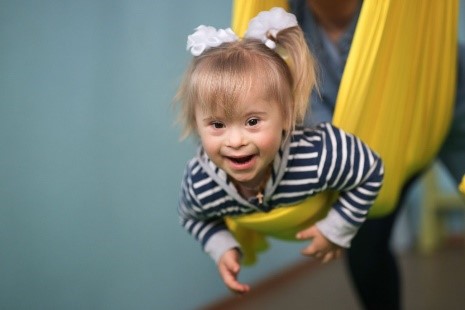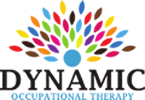
Down Syndrome: A Comprehensive Overview of the Condition and its Management
Down syndrome, a genetic disorder characterised by the presence of an extra copy of chromosome 21, affects approximately 1 in every 700 babies born around the world. This chromosomal anomaly leads to various physical and intellectual challenges, manifesting in distinctive facial features, developmental delays, and varying degrees of intellectual disabilities. The additional genetic material disrupts the natural progression of growth and development, influencing both the physical and cognitive aspects of an individual’s life.
In this article, we will delve deeper into the types of Down syndrome, explore the underlying causes, highlight the vital role of occupational therapy in managing the condition, and identify key red flags for early detection.
Types of Down Syndrome
Down syndrome is categorised into three main types, each with unique characteristics:
1. Trisomy 21:
This is the most prevalent form, accounting for approximately 95% of all Down syndrome cases. Individuals with trisomy 21 possess an extra copy of chromosome 21 in every single one of their cells. This full chromosomal variation often results in the classic features and challenges associated with Down syndrome.
2. Translocation Down Syndrome:
In this less common type, a portion of chromosome 21 becomes attached to another chromosome, often chromosome 14. While the total number of chromosomes remains 46, the translocation results in the presence of extra genetic material that leads to Down syndrome. This form may occur in families, as the translocation can be hereditary.
3. Mosaic Down Syndrome:
The rarest form of Down syndrome, mosaicism arises when an individual has a mixture of two types of cells: some with the typical set of chromosomes and others with three copies of chromosome 21. Because of this variability, individuals with mosaic Down syndrome may exhibit milder symptoms and challenges compared to those with the more common forms.

Causes and Risk Factors
At the heart of Down syndrome lies a random error during cell division known as nondisjunction, which occurs when chromosomes fail to separate properly during the formation of reproductive cells. This error, leading to the development of an embryo with an extra chromosome 21, is not linked to any actions, behaviours, or environmental factors associated with the parents.
One significant risk factor for Down syndrome is advanced maternal age; as women age, particularly beyond 35 years, the likelihood of chromosomal abnormalities during conception increases. However, it’s important to note that the majority of children with Down syndrome are born to younger mothers due to the higher birth rates in this demographic. This highlights that Down syndrome can occur in pregnancies across various ages, irrespective of maternal behaviours or choices.
The Vital Role of Occupational Therapy
Occupational therapy is an integral part of the management and support for individuals with Down syndrome. Through tailored interventions, occupational therapists empower individuals to navigate daily life with greater ease, enhancing their overall quality of life and promoting independence. Several key components of occupational therapy for those with Down syndrome include:

1. Fine and Gross Motor Skills:
Engaging in targeted exercises and activities designed to bolster coordination, balance, and motor skills, empowers individuals to perform daily tasks more efficiently.
2. Sensory Integration:
Occupational therapists work to help individuals better process sensory information, which can improve their reactions and interactions with the world around them, making sensory experiences more manageable.
3. Self-Care Skills:
Therapists teach essential activities of daily living, such as dressing, grooming, and feeding. By focusing on these self-care skills, individuals can develop the independence needed to care for themselves.
4. Social Skills:
Promoting social interaction and communication is critical. Through guided play and social scenarios, individuals are encouraged to develop interpersonal skills that foster meaningful relationships.
5. Cognitive Skills:
Occupational therapy also addresses cognitive development, providing strategies and exercises to enhance attention, concentration, and overall learning capacities.

Red Flags and Early Identification
The early identification of Down syndrome is crucial, as it allows for prompt intervention and support, significantly improving long-term outcomes. Parents and healthcare professionals should be vigilant for several red flags that may indicate Down syndrome. These include:
Distinctive Physical Characteristics:
Such as Almond-shaped eyes, a flat facial profile, a short neck, and a small nose are often observed in individuals with Down syndrome.
Developmental Delays:
Indicators may include delayed milestones in motor skills and language development, as well as cognitive delays that can affect learning and social interaction.
Other Health Considerations:
Common additional challenges may include poor muscle tone (hypotonia), difficulty with feeding, and congenital heart defects, which are present in a significant number of cases.
If these warning signs are recognized, it is essential to seek a thorough evaluation from a healthcare professional. Early intervention services, including occupational therapy, speech therapy, and physical therapy, can profoundly impact the quality of life for individuals with Down syndrome. By addressing developmental delays and challenges at an early stage, individuals can receive the necessary support to flourish and reach their full potential.
Conclusion
A comprehensive understanding of Down syndrome is vital for providing effective and compassionate care to individuals with this condition. By learning about the various types of Down syndrome, the underlying causes, and the significant role of occupational therapy, we can better support individuals in achieving fulfilling lives. Furthermore, recognising early red flags and facilitating timely intervention is crucial in ensuring that individuals with Down syndrome receive the comprehensive support they need to thrive. With the right care and resources, individuals with Down syndrome can overcome challenges, develop their unique skills, and contribute meaningfully to their communities, leading lives of purpose and fulfilment.
References
- National Down Syndrome Society. (n.d.). Types of Down Syndrome. Retrieved from https://www.ndss.org/about-down-syndrome/down-syndrome/types-of-down-syndrome/
- National Down Syndrome Society. (n.d.). Causes of Down Syndrome. Retrieved from https://www.ndss.org/about-down-syndrome/down-syndrome/causes-of-down-syndrome/
- American Occupational Therapy Association. (n.d.). Occupational Therapy and Down Syndrome. Retrieved from https://www.aota.org/About-Occupational-Therapy/Patients-Clients/ChildrenAndYouth/Down-Syndrome.aspx
- Centers for Disease Control and Prevention. (2021, March 2). Facts about Down Syndrome. Retrieved from https://www.cdc.gov/ncbddd/spanish/birthdefects/downsyndrome.html
- National Down Syndrome Society. (n.d.). Early Intervention. Retrieved from https://www.ndss.org/about-down-syndrome/early-intervention/



